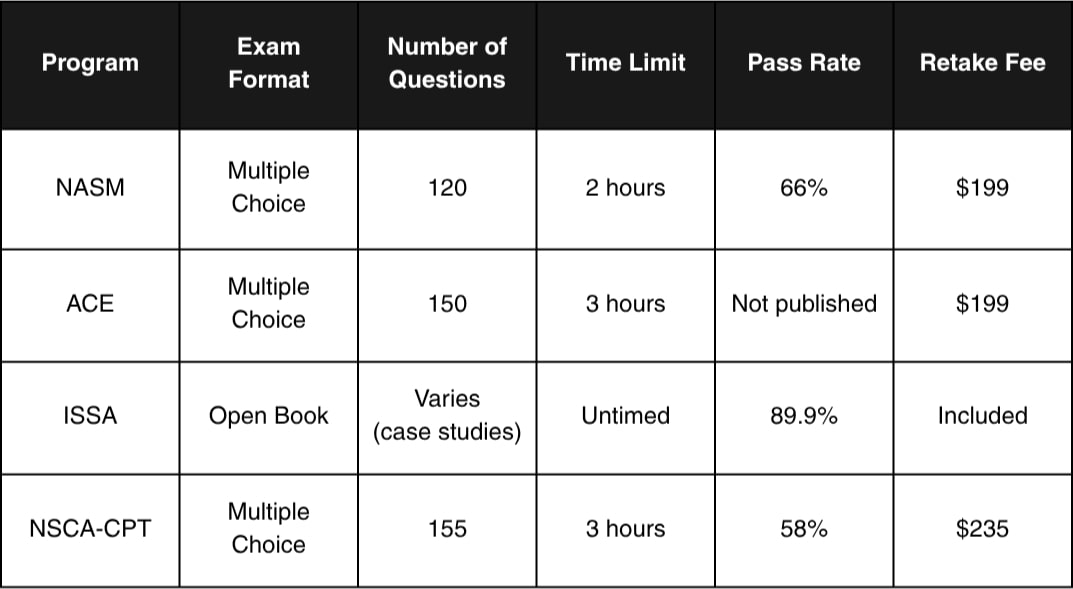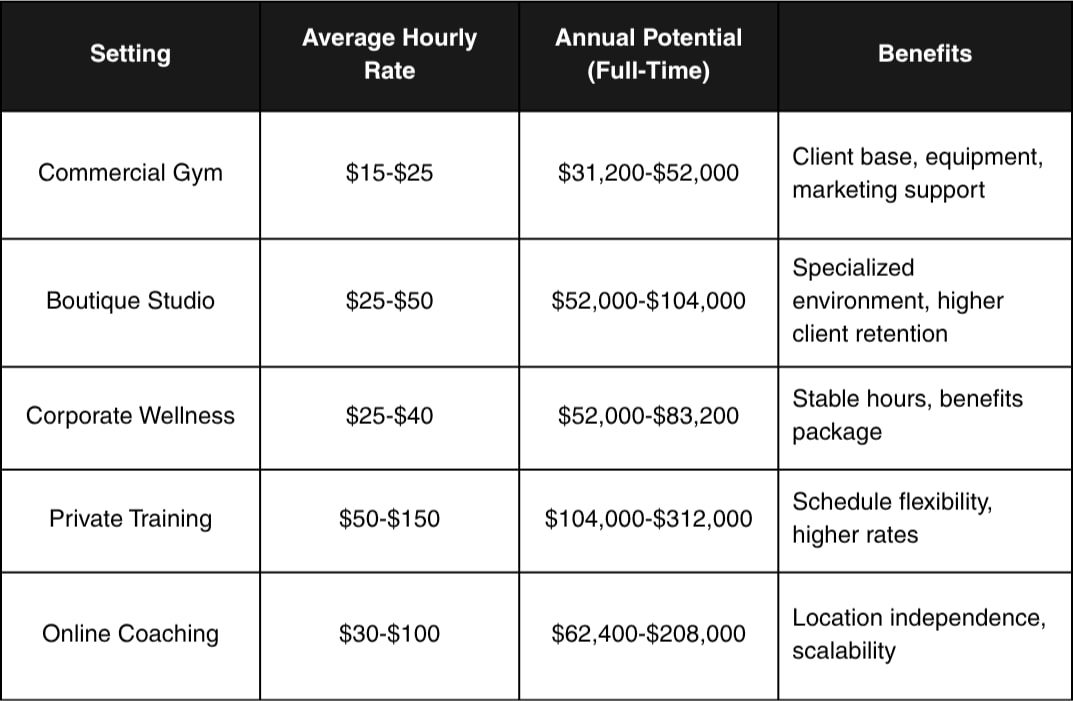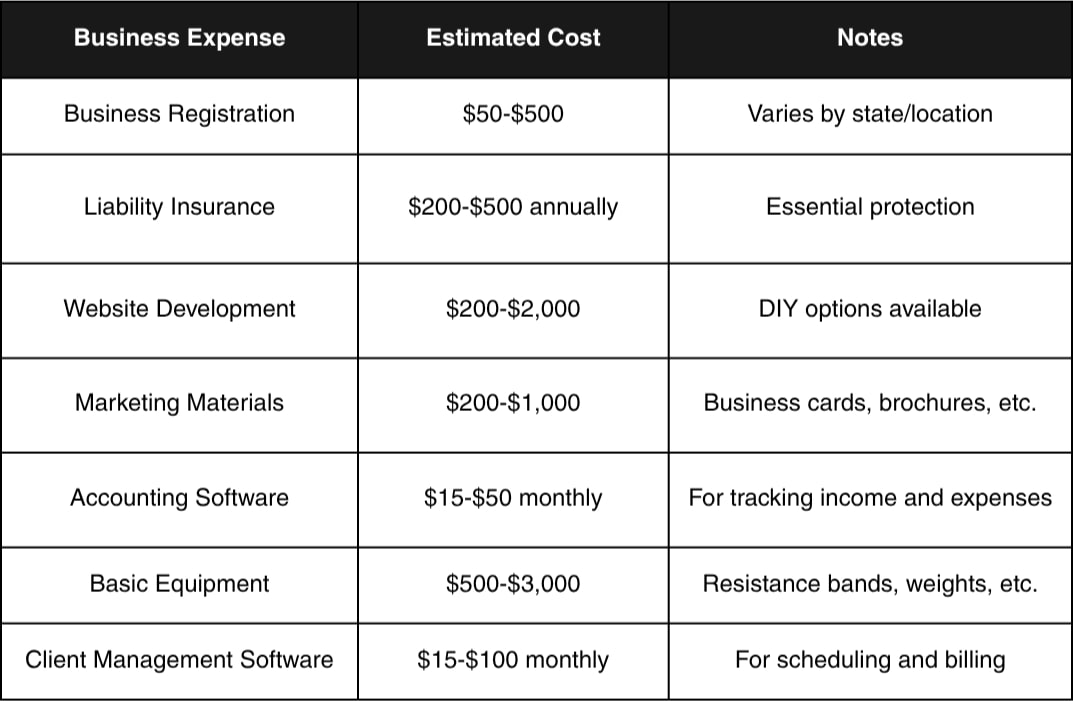Thinking about turning your passion for fitness into a career? You’re not alone. The fitness industry continues to grow as more people prioritize their health and wellness. If you’re wondering how much to become a personal trainer, you’ve come to the right place. This comprehensive guide breaks down everything you need to know about the requirements, costs, and steps to become a certified personal trainer with an NCCA-accredited program.
Many aspiring fitness professionals ask, “How much is it to become a personal trainer?” The short answer is that personal trainer certification cost typically ranges from $800 to $3,000, depending on which certification program you choose and what additional expenses you incur. But there’s much more to the story than just the price tag.
In this article, we’ll explore the full journey of becoming a personal trainer– from basic requirements and certification options to exam preparation and career prospects. Whether you’re a fitness enthusiast looking to share your knowledge or someone seeking a career change to achieve your fitness goals, understanding the complete picture will help you make informed decisions about your future in the fitness industry.
Basic Requirements to Start Your Personal Training Journey
Before diving into specific certification programs, let’s cover the fundamental requirements you’ll need to meet to become a certified personal trainer.
Age and Education Requirements
Most personal trainer certification programs require candidates to:
- Be at least 18 years old
- Hold a high school diploma or equivalent
- Have a current CPR/AED certification
These are the minimum requirements, but having additional education in exercise science, kinesiology, or a related field can give you an advantage. However, if you’re wondering how much to become a personal trainer without a college degree, rest assured that many successful trainers enter the field with just a high school education and the right CPR certification.
CPR and AED Certification
A current CPR AED certification is mandatory for all personal training certification programs. This requirement ensures you can respond appropriately in emergency situations – a crucial skill when working with clients during physical activity.
These certifications typically cost between $50 and $100 and need to be renewed every two years. While this is a small portion of how much is it to become a personal trainer, it’s an essential investment in both your career and your clients’ safety.
Physical Fitness and Knowledge
While there’s no specific fitness test required to become a personal trainer, having a good level of physical fitness and essential knowledge of exercise principles will help you succeed. After all, clients often look to their trainers as role models and sources of inspiration.
Understanding how much to become a personal trainer involves recognizing that your own fitness journey and knowledge base as an elite trainer re valuable assets that don’t necessarily have a price tag but will significantly impact your success.
Comparing Top Personal Trainer Certification Programs
When researching how much is it to become a personal trainer, you’ll quickly discover that the certification program you choose significantly impacts your total investment. Let’s compare some of the most recognized certifications in the industry.
Cost Comparison of Major Certification Programs

As you can see, the cost of personal trainer certification varies widely. When calculating how much to become a personal trainer, consider what each package includes, such as a job guarantee program. Some basic packages only provide study materials and exam access, while premium options might include practice tests, job guarantees, and additional resources.
Program Focus and Specializations
Each certification program has a different focus and teaching methodology:
NASM Certified Personal Trainer
- Known for their Optimum Performance Training (OPT) model
- Strong focus on corrective exercise and movement assessment
- Highly respected in the fitness industry
- More scientific approach to program design
ACE Personal Trainer Certification
- Emphasizes client-centered coaching
- Integrated Fitness Training (IFT) Model
- Focuses on behavior change and motivation
- Practical application of exercise science
ISSA Personal Trainer Certification
- Self-paced study format
- Emphasis on program design for diverse populations
- Business and marketing guidance included
- Open-book, untimed final exam
When determining how much is it to become a personal trainer, consider which NCCA-accredited certification program’s philosophy aligns with your personal training style and career goals, especially regarding the NCCA-accredited exams. The right fit might be worth a higher initial investment.
The Hidden Costs of Becoming a Personal Trainer
Beyond the basic certification cost, there are several additional expenses to consider when calculating how much to become a personal trainer. These “hidden” costs can significantly impact your total investment.
Study Materials and Exam Preparation
While most certification packages include basic study materials, you might want to invest in additional resources:
- Extra practice exams: $50-$150
- Mobile study apps: $10-$50
- Flashcards and study guides: $30-$100
- Tutoring or mentorship: $200-$500
Many professional trainers recommend budgeting for supplementary study aids and course material, especially if you have a learning style that isn’t fully addressed by the standard materials provided.
Insurance and Legal Requirements
Once certified, you’ll need liability insurance before you can start training clients. This essential protection typically costs:
- Basic liability coverage: $150-$300 annually
- Comprehensive professional coverage: $300-$500 annually
This is an ongoing expense that must be factored into how much is it to become a personal trainer over the long term.
Continuing Education Requirements
To maintain your status as a certified personal trainer, you’ll need to complete continuing education units(CEUs) and renew your certification every 2-3 years. Annual costs typically include:
- CEU courses: $100-$300 per year
- Recertification fees: $50-$150 every 2-3 years
- Specialty certifications: $300-$1,000 each
These ongoing education requirements ensure you stay current with industry developments, but add to the total cost of maintaining your career.
Exam Details and Preparation Strategies
Understanding the certification exam structure and preparing effectively for the final exam is crucial to passing on your first attempt – saving you from paying retake fees and adding to how much to become a personal trainer.
Exam Structure and Pass Rates

The final exam format varies significantly between certifying agencies. ISSA’s open-book approach explains its higher pass rate, while NASM and NSCA have more challenging closed-book exams with lower pass rates.
Effective Study Strategies
To maximize your chances of passing the certification exam on the first try:
- Create a study schedule and stick to it (3-6 months of preparation is typical)
- Utilize all provided study materials, including textbooks, videos, and practice questions
- Join study groups or online forums to discuss concepts with other students
- Take multiple practice exams to identify knowledge gaps
- Focus on understanding concepts rather than memorizing facts
Many successful certified personal trainers recommend studying 10-15 hours per week for at least 3 months before taking the exam. This dedicated preparation helps ensure you don’t have to pay additional fees for retakes, keeping how much is it to become a personal trainer as low as possible.
Career Prospects and Earning Potential
When considering how much to become a personal trainer, it’s important to weigh the initial investment against your potential earnings. The fitness career path offers various opportunities with different income potentials.
Salary Expectations by Work Environment

These figures help put into perspective how much is it to become a personal trainer relative to your earning potential. While the initial certification costs might seem significant, they’re relatively small compared to the lifetime earning potential in the field.
Growth Opportunities
The fitness industry continues to expand, with the Bureau of Labor Statistics projecting a 14% growth rate for fitness trainers through 2033. This growth exceeds the average for all occupations, indicating strong demand for qualified personal trainers.
As you gain experience, you can increase your income through:
- Specialization in high-demand areas like senior fitness or athletic performance
- Developing a personal training business with multiple revenue streams
- Creating online programs or content to reach more clients
- Advancing to management positions within fitness centers
Understanding the long-term financial picture helps put into perspective how much to become a personal trainer as an investment rather than simply an expense.
Specializations and Additional Certifications
Once you’ve obtained your basic personal trainer certification, specializing can help you stand out in the competitive fitness industry and command higher rates. However, these additional certifications will add to how the cost it to become a personal trainer overall.
Popular Specialization Areas

Many successful fitness professionals hold multiple certifications, enabling them to work with diverse client populations and address a range of needs. While this increases how much to become a personal trainer initially, it typically pays off through higher rates and more client opportunities.
Return on Investment Considerations
When calculating how much is it to become a personal trainer with specializations, consider:
- The popularity and demand for the specialty in your area
- Whether the specialization aligns with your interests and strengths
- The potential for increased client retention and referrals
- The ability to charge premium rates for specialized services
For example, investing $500 in a nutrition coaching certification might allow you to charge an additional $15-$25 per session, meaning you could recoup your investment after just 20-30 sessions.
Online vs. In-Person Certification Options
The rise of online personal training certification programs has created more flexible options for aspiring trainers. When considering how much to become a personal trainer, the study format can significantly impact both costs and convenience.
Comparing Online and In-Person Programs

Online programs typically offer a more affordable path when calculating how much is it to become a personal trainer. However, in-person programs may provide more hands-on experience and networking opportunities that could benefit your career long-term as an online personal trainer.
Self-Study vs. Guided Programs
Many certification organizations offer tiered packages:
- Self-Study: The most affordable option (reducing how much to become a personal trainer), but requires self-discipline and independent learning skills.
- Guided Study: More expensive but includes structured learning paths, instructor support, and accountability.
- Premium Programs: The most comprehensive (and costly) option, often including mentorship, job placement assistance, and business development resources.
Your learning style and schedule should guide this decision as much as the price difference. Saving money on a self-study program might not be worth it if you struggle to stay motivated without structure.
The Business Side of Personal Training
Understanding the business aspects of personal training is crucial when calculating how much to become a fitness trainer in the long run. Starting a personal training business involves additional costs beyond certification.
Setting Up Your Personal Training Business
If you plan to work independently rather than for a gym or fitness club, consider these startup costs:

These expenses significantly impact how much is it to become a personal trainer who runs their own business versus working for an established facility.
Employment vs. Independent Contracting
When starting your career as a certified personal trainer, you’ll typically choose between:
- Employee Status: Working for a gym with a regular salary or hourly wage plus commission. Lower initial investment (the gym provides equipment and clients)
- More stable income but typically lower earning potential
- Benefits may include health insurance and paid time off
Independent Contractor: Working within a facility but managing your own client base
- Moderate investment (you pay rent to the facility but use their equipment)
- More freedom but less stability
- Responsible for your own taxes and insurance
Self-Employed: Running your own training business
- Highest potential income but also the highest initial investment
- Complete freedom and flexibility
- Responsible for all aspects of business management
Each path affects how much to become a personal trainer in terms of both initial and ongoing costs, as well as potential returns.
Typical Timeline to Becoming a Certified Personal Trainer

This timeline helps illustrate that becoming a successful personal trainer is a process that extends beyond merely obtaining certification. When calculating how much to become a personal trainer, consider the full journey rather than just the certification cost.
Making the Most of Your Certification Investment
To maximize the return on your investment in personal training certification, consider these strategies from successful fitness professionals.
Choosing the Right Certification for Your Goals
When deciding how much to become a personal trainer, consider which certification best aligns with your career goals:
- ACE Personal Trainer Certification: Excellent for those wanting to work with the general population clients
- NASM Certified Personal Trainer: Ideal if you’re interested in corrective exercise and movement assessment
- ISSA Personal Trainer Certification: Great for those who prefer self-paced learning and want business guidance
- NSCA-CPT: Perfect for those interested in strength and conditioning for athletes
The right certification for your specific goals might not be the cheapest option, but it could provide better long-term value.
Maximizing Study Efficiency
To get the most value from your certification investment:
- Create a detailed study schedule before purchasing materials
- Utilize free resources like YouTube videos and study groups to supplement official materials
- Take advantage of all included resources (practice tests, study guides, etc.)
- Consider forming a study group to share insights and motivation
- Use spaced repetition techniques to improve retention
Efficient study methods help ensure you pass the certification exam on the first attempt, preventing additional costs from retakes.
Final Words
If you love fitness and are passionate about training people, then personal training is a rewarding career for you. Certification price for the most reputable program in the United States ranges from $300 to $2000. However, you don't need to enroll in the most costly program, as a basic package can prepare you for the examination.
ISSA, NASM, and ACE are good options and cost almost the same. Enrolling in these programs is value for money as it boosts your credibility and enables you to land a better job and increase your earning potential.
Now, you know how much to become a personal trainer, we also encourage you to explore FitBudd, an all-in-one platform for coaches and personal trainers, where you can easily track your clientele, work progress, and build plans from a single dashboard.
Frequently Asked Questions About Becoming a Personal Trainer
1. How much does it really cost to become a personal trainer?
The total cost to become a certified personal trainer typically ranges from $800 to $3,000 for the certification alone. When calculating how much to become a personal trainer, you should also factor in CPR/AED certification ($50-$100), study materials ($50-$300), liability insurance ($200-$500 annually), and continuing education ($200-$500 annually). Your total first-year investment will likely be between $1,100 and $4,000, depending on which certified trainers' certification and additional resources you choose.
2. Which personal trainer certification is most respected?
There’s no single “best” certification, as different employers and clients value different programs. However, certifications from NASM, ACE, ISSA, and NSCA are widely recognized and respected in the fitness industry. When researching how much is it to become a personal trainer, consider which certification is most prevalent in your target work environment. For example, NASM and ACE are often preferred in commercial gyms, while NSCA might be more valued in athletic settings.
3. How long does it take to become a certified personal trainer?
Most people complete their personal trainer certification in 3-6 months of part-time studying. The timeline depends on your background knowledge, study habits, and the certification program you choose. Some intensive programs can be completed in as little as 4-8 weeks of full-time study, while self-paced options allow you to take up to a year or more if needed.
4. What is the cheapest PT license?
The IPTA certification offers the most affordable option, with a starting price of $399 and a maximum price of $699. On the other hand, NASM has the highest price range, with the cheapest package at $948 and the most expensive reaching $1,597.
92% trainers worldwide gave us 5 stars
Talk to your dedicated success manager and launch your branded fitness app during the demo in minutes.
Start your paid subscription for $79 FREE

%20to%20Become%20a%20Certified%20Personal%20Trainer-min.jpg)








